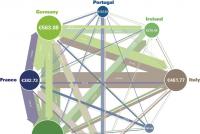History of the Central Bank of England. The history of the creation of central banks on the example of the first Central Bank - the Bank of England
England occupies a special place of honor, and for good reason. In fact, he is a double record holder. In addition to the fact that its age is much older than all other European state-owned banks, it is also the oldest financial institution in everything. It is not for nothing that they came up with the playful name “Old Lady”, thus hinting at its conservatism.
How and when was the Central Bank of England founded?
The history of this organization begins in 1694. At that time, the government and the king of England needed a loan to finance the war against France. One Scottish financier, whose name was William Peterson, came up with the idea of creating a special financial institution that would print new banknotes and thus cover. . The amount of the first installment was one thousand two hundred pounds sterling, and these funds became the first loan to the government of the country. This is how the Bank of England appeared - an organization without which it is difficult to imagine what the financial system of Great Britain itself and many other countries would be like.

History of formation
At first, this organization had the right to provide secured loans, conduct transactions with commercial bills, issue bills of exchange, buy and sell silver and gold. The king did not have absolute power over her - in order to receive a loan, he had to obtain permission from parliament. It must be said that until 1979 there were no regulatory documents regulating the work of this institution. And only this year, finally, an appropriate law was adopted, according to which the Bank of England systematizes all accepting deposits. From now on, after verification, each of them receives a new status. They become either recognized banks in England or licensed deposit taking companies. In the same year, 1979, the power in the country is taken over by the conservatives, who are headed and become the center of attention. The control of the banks is carried out by the government through the sale and purchase of bills. Then the 1990s come, and operations on the open market are considered a priority.

The Bank of England, following the decree of the Treasury, enters into transactions in order to regulate the level. In addition, it can and is obliged to carry out interventions to control the exchange rate of the national currency. In 1997, a Memorandum was signed between the Bank of England, the Office for Supervision and Financial Regulation and the Treasury, which describes the principles and conditions for their smooth work aimed at ensuring the financial stability of the state. In the same year, in May, the Central Bank receives from the government the right to make its own decision on the value of interest rates.
Control
This financial institution is headed by a manager (service term - 5 years), who is a member of the directorate. In addition to him, this body includes 16 more members appointed by the government for a three-year term. 4 directors are included in the staff of the Bank itself, and the remaining 12 are the heads of the largest companies. The Directorate is obliged to meet at least once a month and resolve all issues that are somehow related to the functions of the Bank. Any practical issues are resolved at the level of the Treasury Committee, which consists of 5 directors, a manager and his deputy.
On July 27, 1694, the enterprising Scottish merchant William Paterson created the Bank of England (eng. Bank of England) - the oldest central bank in the world and a special public law institution in Great Britain, which performs the functions of the central bank of the United Kingdom. It organizes the work of the Monetary Policy Committee, which is responsible for managing the country's monetary policy.
Initially, the institution was organized as a private joint-stock bank. The company was made up of 1,268 shareholders who provided 1 million 200 thousand pounds sterling as a loan at 8% per annum to King William III, who was in dire need of funds to continue the war with France (1689−1697).
In return, the king gave the Bank of England the right to operate as a limited liability company. Such a right was not granted to any British bank until 1826. The resulting status and position of a government financial agency ruled out any possibility of competition with it from other banks in the kingdom. It is clear that such preferences constantly had to be defended in a fierce struggle.
This had to be done for the first time already in 1696, when the Bank of England, run by the magnates of the ruling Whig political party, faced the threat of competition. The Tory party attempted to set up a new National Bank, and although the venture failed, the Bank of England acted immediately. The following year, Parliament passed a law forbidding the establishment of large banks in England. According to the same law, counterfeiting banknotes of the Bank of England was punishable by death.
In 1708, the law became even more stringent. Now it has become illegal to issue bearer bills (this right was given only to the Bank of England) and to create companies consisting of more than 6 partners, as well as to provide short-term loans for up to 6 months.
Since 1734, the largest English bank has been located at Thread-needle Street, London, in a building designed by the architect John Soane - later rebuilt by Herbert Baker. The management structure in this institution has not changed much over the past three centuries. The Bank of England is governed by a Board of Directors. It consists of the Governor (the Governor), two of his deputies (Deputy Governors) and 16 members of the Board (Non-Executive Directors). They are all appointed by Royal Decree after approval by the UK Parliament. The manager and his deputies are appointed for five years, members of the Board of Directors - for four years. All of them can be appointed for the following terms.
In 1946, after the passage of the Bank of England Act, it was nationalized and began to operate as a state bank. Having gained de facto independence on May 6, 1997, today the Bank is authorized to promote the development and maintenance of the entire monetary and financial system of Great Britain at a stable level. It acts as the central bank of the United Kingdom.
The Bank of England is the oldest central bank in the world. This institution appeared at the end of the seventeenth century - in 1694, as a result of the so-called agreement between an almost bankrupt government and a group of financiers. To wage war with France, the government needed a large loan, for the issuance of which several London merchants united in one private joint-stock bank. As a gratitude for the service, they received the right to accept deposits, discount bills, and issue tickets to bearer of a single value corresponding to a certain weight of the metal.
The war with France (1793-1815) required huge expenses from England, partly covered by loans from the Bank of England and the purchase of foreign raw materials. Foreigners converted banknotes into gold and took it abroad. As a result, in 1797 the bank's reserves were exhausted and it was on the verge of bankruptcy. The government passed a "restriction act" that prohibited the Bank of England from converting banknotes into gold. As a result, the issuing activity of the bank increased.
The exchange of banknotes for gold was restored only in 1821. In 1844, parliament legislated the function of the exclusive issuer of banknotes to the central bank.
In 1946 the Bank of England was nationalized. The Bank of England Act was passed, according to which the share capital of the Bank of England was transferred to the Treasury, and the former owners of shares received generous compensation in the form of 3% government bonds (the exchange of shares for bonds was carried out in a ratio of 1: 4, i. 4 times the par value of the shares). The Bank of England began to officially act as the government's banker. Under the Bank of England Act, the Treasury may, after prior consultation with the Governor of the Bank of England, make recommendations to the Bank, which it must comply with. Formally, the responsibility for the decision in the field of monetary policy lies with the head of the treasury, which is accountable to parliament.
The Bank advises the government on monetary policy issues and coordinates these issues with the Treasury. Thus, very broad rights of the treasury in relation to the bank are fixed by law.
Among the central banks of industrialized countries, the Bank of England is one of the most legally dependent on the government. In practice, the Bank of England works in close contact with the Treasury and it is difficult to overestimate its role in regulating the monetary and foreign exchange sphere, in managing public debt.
Governance structure of the Bank of England
- Bank manager, (for 5 years)
- his deputies (for 5 years)
- 16 directors (for 4 years)
Officially appointed by the Queen, but in fact the candidates are determined by the Minister of Finance after consultation with the Governor. The manager and his deputies are appointed for 5 years, directors for 4 years. 4 out of 16 directors are replaced annually. 4 executive directors work in the bank on a permanent basis, the remaining 12 represent commercial banks and industry.
The Board of Directors holds weekly meetings, but does not participate in political decision-making. The activity of the council is aimed at ensuring that the views of various circles are taken into account.
By law, the government has the right to release employees from leadership positions before the specified period. With regard to the manager, this practice has never been applied. The Bank of England is not an independent central bank and is accountable to the Secretary of the Treasury, who is responsible to Parliament for monetary policy. The formal dependence of the Bank of England on the Ministry of Finance seemed to experts the main obstacle to joining the European Monetary Union.
In 1979 - the first English comprehensive banking law. He secured for the Bank of England the right to oversee the banking system. The establishment of a depository institution requires permission from the Bank of England. In 1987, the Bank of England received additional rights and obligations to supervise banking activities. However, a decade later, in 1997, the function of banking supervision was transferred to another newly created supervisory body.
Currently, the Bank of England operates on the basis of three priority goals:
1- support the value of the national currency
2 - ensuring the stability of the financial system
3 - ensuring and increasing the efficiency and competitiveness of the financial system within the country and in the international arena.
Functions:
1- provides a range of services to its clients.
However, the clients of the Bank of England are different from those of other banks. There are 3 most important customer groups:
commercial banks. All clearing banks have accounts with the Bank of England. They are required to have a certain amount in the account and are not allowed to exceed it. All banks operating in the UK keep 0.35% of their deposits in an account with a Bank of England. This reserve ratio is the main source of income for the Bank of England.
Central banks of other countries - have accounts and hold gold in England, can do business in London through the Bank of England.
Government - all payments, taxes to the budget and payments from the budget go through the accounts of the Bank of England.
In this role, the Bank of England acts, relying mainly on tradition, and not on legal norms. A variety of rules and procedures that govern the activities of credit and banking institutions are established by way of "gentleman's agreements" between these institutions and the Bank of England.
In line with the foregoing, the Bank of England plays a threefold role:
1.serves as a bank for commercial banks
2. serves as a bank for other central banks
3.serves as a bank for the government
2- implements monetary policy, the main goal of which is to achieve price stability.
Inflation is maintained at 2.5%. The policy of interest rates and interventions is used. Interventions are openly spoken about and covered widely.
The implementation of monetary policy, that is, the determination, mainly, of the level of interest rates that ensure the achievement of inflationary goals, is entrusted to the Bank of England and the Treasury (the Bank of England, unlike other banks, cannot act independently of the government). The Bank of England Act of 1946 gives the Treasury the power to give direction to the Bank of England and, although the Treasury has never exercised this power, the relationship between them is such that the final decisions on interest rates are made by the Secretary of the Treasury. However, the Bank of England plays a very important role in the decision. Now the Bank of England publishes a quarterly Inflation Report, which contains a detailed analysis of the information, as well as the minutes of the meeting between the Minister and the Governor of the Bank (published 6 weeks after their meeting) on interest rates.
The main instruments of monetary policy varied depending on the state of the national economy and political priorities.
In the 1940s, monetary policy, in accordance with Keynesian ideas, was considered as an addition to financial policy and was aimed mainly at reducing the cost of public debt to the maximum: a policy of "cheap money" was pursued, i.e. keeping interest rates low.
The Bank of England did not use such a traditional method of regulation as changing the discount rate. The main instrument of monetary policy was the establishment of a fixed ratio of cash reserves to bank deposits and open market operations.
In the 1950s and 1960s, the features of the monetary control mechanism were frequent changes in the official discount rate, tightening or loosening of direct restrictions on bank loans, depending on the state of the economic situation, the state of the balance of payments, and the scale of inflation.
In 1971, the conservatives who came to power proclaimed a "new approach" to monetary regulation. Direct credit restrictions were lifted and measures were taken to increase competition in the banking sector. This was accompanied by a sharp increase in the money supply and prices. The Bank of England returned to the active use of previously used direct methods of limiting credit; in addition, limits were set for the growth of the money supply, and a number of measures were taken to stimulate the placement of government debt obligations outside the banking system.
With the coming to power in 1979 of the conservative government of M. Thatcher, the direction of monetary policy began to be determined by the deviation of the growth rate of the money supply from the established limits. The main method of control of the Bank of England over the growth of the money supply was its operations for the purchase and sale of bills, and mainly commercial, not treasury ones, and the placement of government obligations outside the banking system.
In the 1990s, the main instrument of monetary policy in Great Britain, as in other developed countries, was open market operations.
3- is the issuer of banknotes.
The Bank of England has been issuing its banknotes for over 300 years. Banknote design and production is a function of the Essex bank printing factory. The bank supplies banknotes to 5 of its branches - in Bristol, Birgingham, Leeds, Manchester, Newcastle.
Since 1844, the Bank of England has been divided into two departments:
Emission, associated only with the issuance of banknotes and
Banking, which carries out all other operations.
This separation was made for accounting purposes. The banknotes issued by the issuing department are transferred to the banking department, where they lie as a reserve until they are required by customers. The issuance of banknotes is completely fiduciary, i.e. backed not by gold, but by various obligations.
In addition, the Bank of England also performs the following functions:
4 - carries out foreign exchange transactions and control, management of the country's gold and foreign exchange reserves on behalf of the Treasury
5 - supervises credit institutions, foreign exchange and credit markets, the banking system as a whole
6 - collects statistical information about the money supply and the activities of banks
The Bank of England has 12 territorial branches.
The prehistory of the creation of the Bank of England is as follows.
Under the influence of the Reformation, which was just beginning to unfold in Europe, the English King Henry VIII (1509-1547) significantly weakened the laws regarding usury. In the first half of the XVI century. moneylenders significantly expanded the supply of gold and silver coins, the country experienced a revival of economic activity. But then the daughter of Henry VIII, Queen Mary Tudor (1553-1558), came to power, who again tightened the laws on usury. The supply of coins dropped significantly, the country fell into a depression. After a five-year reign, power passed from Mary to her sister, Queen Elizabeth I (1558-1603). In order to put the economy in disorder in the country in order, she decided to take control of the issue of money in her own hands. First of all, she decided to make the minting of gold and silver coins the exclusive prerogative of the Royal Treasury.
The need for usurers has fallen sharply, but the interest on their loans has become minimal. Queen Elizabeth I entered into a direct confrontation with usurers.
The usurers began to prepare a revolution, making Oliver Cromwell their henchman. It all ended, as we know, with the overthrow of King Charles I, the dissolution of parliament, and the execution of the monarch. Of course, these events cannot be explained solely by the fact that the royal power took over the minting of coins, but this is an important cause of the English revolution. Jacob Stewart (1685-1688) was placed on the throne. A civil war began in the country, which did not give usurers the opportunity to fully establish their power. And then William (William) of Orange appears on the scene - a reliable protege of usurers. According to historians, his rise to power was supported by the Dutch and English usurers. The Stuarts were deposed from the throne, and William of Orange took the place of James, who became known as William III (1688-1702). On behalf of and on behalf of a group of usurers, negotiations with the new king were conducted by the well-known swindler William Patterson at that time (before that, he tried to make big money on the colonization of the Isthmus of Panama, but to no avail).
For their "service" in providing a loan, they demanded a counter "service" from William of Orange:
- firstly, agree to the creation of a special bank that would be the monopoly issuer of paper money circulating throughout the country;
- secondly, this bank was supposed to become the exclusive creditor of the government, issuing loans at 8% per annum in exchange for government promissory notes (bonds);
- thirdly, to allow the bank to partially reserve its obligations, i.e. actually allow to make money "out of thin air";
- fourthly, it was proposed to make the main “reserve” of the bank not gold, but government promissory notes;
at the expense of the latter, crediting to the government should be fully ensured, as well as the issuance of other loans.
In fact, the “draft” of W. Paterson contained all the main elements of the modern mechanism for issuing money by the central banks of developed countries (with the exception of the fact that the “draft” also provided for the use of gold, although its role was already secondary).
Basically, all the demands of moneylenders were satisfied (although not completely - for example, the rights to issue national money were also reserved for other banks). This is how the Bank of England arose, while he had the right to issue credit money (paper pounds sterling) twice as much as there was gold in stocks. In the first year, the Bank of England gave the King a loan of £1,200,000, with £720.00 worth of gold in the vaults of the bank. Loans to the government and interest on them were repaid through taxes.
Such a system suited both moneylenders - shareholders of the Bank of England, and government officials, because. they had access to a permanent source of credit. Under such a system, Bank of England shareholder profits and government debt rose rapidly. The system gave rise to boundless corruption, contributed to the merging of the financial power of usurers and the "administrative resource" of government officials.
Only the English people were at a loss: they bore the tax burden generated by debt. In addition, all the hardships of the crises that were inevitable with the rapid growth of debt fell on him. Finally, it must be taken into account that part of the Bank of England loans was not secured by either gold or commodities. Therefore, contrary to the well-established notions that “in those days there could be no inflation,” prices rose in the country, which primarily hit ordinary British people.
The "flight" from the paper pound to gold began. Therefore, already in 1696, the king issued a law prohibiting the Bank of England from paying "in kind", i.e. gold. Thus, just a few years after the founding of the Bank of England, the mechanism of money emission became what it is today in the United States and other developed countries.
Very soon, however, the “glorious time” for the government ended: the debts grew so rapidly that there were no longer enough taxes to service and repay them. The only way for the authorities to get out of this "impasse" was to start a war.
Indeed, a series of wars of England for the seizure of colonies and world domination began ...
The result of these wars was an even greater weakening of the authorities while strengthening the positions of the shareholders of the Bank of England and other moneylenders. At the end of the 18th century, the gold reserves of the Bank of England were so depleted by the war that in 1797 the government forbade any payments in gold at all. In 1816, after the Napoleonic Wars, the gold standard was introduced in England, providing for the free exchange of paper pounds for yellow metal by the Bank of England. However, the Bank of England immediately began issuing notes significantly more than there was gold in its vaults, which contributed to the crisis of 1825.
After that, a rather influential group of supporters of "curbing" the issuing activity of the Bank of England appeared in England - the so-called "monetary school", whose representatives believed that the crisis of 1825. arose due to the “separation” of the issue of money by the Bank of England from its metal reserve. Yes, and the sad experience of King William on the actual "disconnection" of money emission from gold, which ended in rampant inflation in the late 17th and early 18th centuries, was also remembered.
The representatives of the "monetary school" were opposed by the so-called "banking school", whose representatives believed that the issue of money by the central bank should not be determined by gold reserves, but linked to the economy's needs for money. This linkage should be ensured by the issuance of banknotes secured by bills, i.e. ultimately goods. Without going into details of the then discussion between the two schools, we note that it affected only the activities of the Bank of England. And almost no one remembered the full reservation of commercial banks.
In 1844, a new milestone came in the development of the Bank of England. We have already mentioned above that in that year the so-called Peel Act was adopted, which introduced a number of innovations in the activities of the country's central bank.
First of all, it was established that the Bank of England receives exclusive rights in the issuance of banknotes in the country. At the same time, however, other banks were not deprived of the right to issue, but the maximum volume of their issue was fixed at the level of 1844. From that moment on, the Bank of England actually received the right to 2/3 of the entire issue of banknotes in the country, and this share increased every year. Other banks gradually "left the game": for 1844-1921. all banks except the Bank of England (207 private banking houses and 72 joint-stock banks) stopped issuing activities. This did not mean, of course, the weakening of the positions of other banks. Many of them continued to increase their capital and assets. But now they began to deal exclusively with the issue of non-cash (deposit) money.
Secondly, the high level of gold coverage of the banknote issue by the Bank of England was determined. To a certain extent, the move to ensure a high degree of gold coverage of the issue was not only an internal matter for the Bank of England. After all, Great Britain was the initiator of the spread of the gold standard around the world, and it was doomed to show by its own example what a real gold standard is. At the same time, it should be noted that the Peel Act was repeatedly suspended until the abolition of the gold standard in 1930, which made it possible for the country's central bank to significantly increase the issue of paper money.
Concluding the conversation about the Bank of England, it should be said that from the very beginning it was private enterprise belonging not to the state, but to individuals.
The founding shareholders included the King and Queen, who made a down payment of £10,000. Then another 633 people contributed amounts that were more than 500 pounds, which gave them the right to vote at shareholders' meetings.
In 1946, i.e. two and a half centuries after its creation, the Bank of England was nationalized by the Labor government (by the way, the list of shareholders is still classified). Even earlier, in 1931, when England abolished the gold standard, the gold reserves of the Bank of England were transferred to the Treasury (Ministry of Finance).
However, today the Bank of England is de facto controlled not by the government, but by the private banks of the City of London:
"The Bank of England has been, and continues to be, a private bank, pursuing the interests of a specific, very narrow group of persons."
As always happens in a period of global instability, we, that is, ordinary citizens, are being flooded with propaganda that is designed to confuse us and set us up for certain actions that we must perform in the selfish interests of manipulators. And the economy in this flow of propaganda occupies a central place, because the well-being of everyone directly depends on its condition. I propose to start expanding our knowledge of the economy with you by studying how the national currency is issued in the UK, because it was from this country that the "fashion" for central banks officially independent of the state went.
As is usually the case with England, the financial situation in this country is very, very confused. Officially, a total of 8 (!!!) banks have the right to issue the pound sterling:
- The Governor and Company of the Bank of England is the Bank of England itself.
- The Royal Bank of Scotland - The Royal Bank of Scotland.
- The Bank of Scotland - Bank of Scotland.
- The Clydesdale Bank - Clydesdale Bank (Scotland).
- Bank of Ireland - Bank of Ireland.
- First Trust Bank Allied Irish Banks - First Trust Bank (Ireland).
- Northern Bank - Northern Bank (Ireland).
- Ulster Bank - Bank of Ulster (Ireland).
Bank of England stands above all, so I propose to start studying with him. This bank was founded in 1694 as a private bank. In 1946 the Bank of England was nationalized
. In 1997, the Bank of England was granted the status of an independent public organization, but the full owner of which is the Soloist of the Ministry of Finance on behalf of the Government. The Bank is governed by a Board of Directors, whose members are approved by the UK Parliament and then appointed by Royal Decree. It should be noted that in England the key rate is set not by the Board of Directors of the Central Bank, but by the Monetary Policy Committee of the Bank of England, which includes 5 representatives from the Central Bank and four independent experts (i.e., if necessary, the necessary decision can be made employees of the Bank of England). The control of the financial sector on the Island is carried out not only by the Bank of England, but also by the Treasury with the UK Financial Conduct Authority. This is such an explosive mixture. But, if you look closely, you can see that everything and everyone is drawn to ... the Royal Court, i.e. to the head of the UK. Is it possible to speak of the Bank of England as a "private" shop, if the main foam is removed from it by the head of state?
The Royal Bank of Scotland also a very, very interesting structure. He himself belongs to the RBS Group, 81% of which, according to somewhat obscure schemes, belongs to the UK Treasury. It turns out that in fact the bank also belongs to the British crown. A small digression: before leaving the Russian market, the representative offices of this bank were in Moscow, St. Petersburg and Yuzhno-Sakhalinsk(were there any strings?). At the same time, this bank has assets worth more than 1 trillion pounds (about 85 trillion rubles at the current exchange rate). Colossal dimensions.
The Bank of Scotland no less interesting structure. Included in Lloyds Banking Group. In this banking group, about 17% of the shares are owned by the same UK Treasury. The Internet is full of rumors that this bank is a "pocket" for the Rothschild family. In principle, this is not excluded, because during the crisis of 2009, the British Government helped Lloyds very well, and then for some reason began to get rid of its shares, although the state does not even plan to reduce its share in RBS Group.
With The Clydesdale Bank it's also not that simple. In 1987 it was bought out by National Australia Bank. Judging by how aggressively the Australian bank has been buying up financial structures in recent years, it can be assumed that behind it are very, very influential financial structures that transport their capital to warmer climes. It is worth noting that the issue of this bank in 2009 helped to get out of debt to the two above-mentioned Scottish banks. In addition, this Australian financial institution is headed by financiers who received their education in the UK.
To date, the issue of Scottish banks is regulated by Bank Notes (Scotland) Act 1845, according to which, when issuing pounds, banks must provide reserve deposits in the Bank of England at a ratio of 1: 1. This restriction does not include an issue in the amount of assets that banks had in 1845. What were the asset sizes? History is silent on this. It is alleged that today there are about 4 billion pounds (about 400 billion rubles) printed by Scottish banks in circulation.
Bank of Ireland was founded in 1781. Actually, everything else about this bank is unknown. Commercial Bank? Yes. Who owns? Silence. The only thing that can be said about him is that today the Bank of Ireland is headed by Richie Boucher, who comes from The Royal Bank of Scotland. In my opinion, a very interesting assignment.
First Trust Bank Allied Irish Banks belongs to one of the largest banks in Ireland: Northern Bank itself was one of the founders of Danske Bank. Apparently, in 2004, due to the change in the places of the terms, the main owner and beneficiary did not change.
With Ulster Bank everything is very simple: it belongs to the RBS Group, i.е. Government of the UK.
What can be concluded from all of the above? First, the British pound issuance system is complex. Very. Secondly, the financial management system in the UK is as complex as issuance. Thirdly, only those who are not very versed in what is “private” and what is “state” property, or those who, for some personal reasons, do it on purpose, can call the Bank of England a “private shop”. To put it more clearly, today the English financial system is governed by a "gentlemen's agreement" between the state and financial corporations, which, apparently, benefits both parties. If, for any reason, this agreement becomes a burden for one of the parties, then breaking it is a matter of technique (the example of 1946 is very indicative).
By the way, if you take a closer look, according to one scheme or another, almost all financial threads go to the British monarchy. That's where the free market is. And his hand.






